浅谈翻译中的不对等性
- 格式:doc
- 大小:20.50 KB
- 文档页数:2
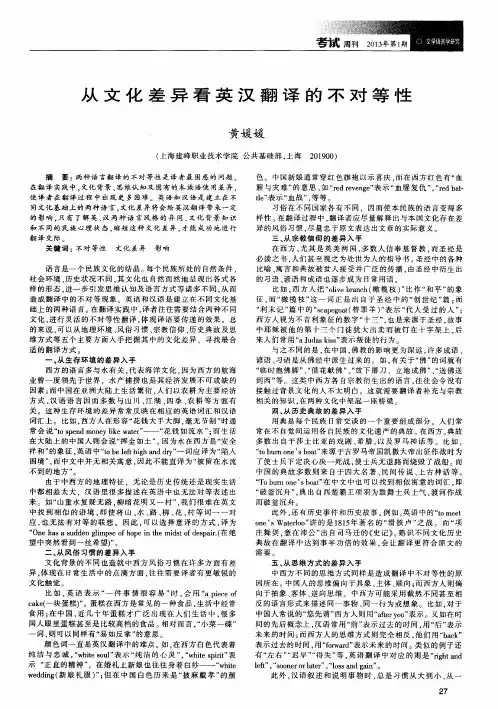

Wide Angle | 广角MODERN BUSINESS现代商业284商务英语翻译中的不对等性及其翻译策略宾露 中南财经政法大学外国语学院 湖北武汉 430223摘要:随着全球化进程的逐步推进和科技迅猛发展,不同文化之间的交流也日渐频繁。
翻译工作在跨商务交流的过程中作用也越来越突出。
翻译理论也随之不断改革创新,将人们在跨文化交流过程中由于语言文化背景不同,交际语用失误和文化冲撞考虑等诸多文化因素考虑其中,以克服翻译方面的重重困难。
中国的经济发展迅速,与世界各国的文化交流也在逐步逐日加深,尤其是商务贸易往来日益密切,商务翻译的重要性与需求也相应增加,商务翻译的研究工作也不容小觑。
然而,由于人们误解商务英语翻译较为简单直白,文化差异较小,所以其研究工作却没得到应有的重视。
针对这种现象,本论文试图通过阐释英汉商务英语翻译中各种不对等现象,并提出相应的翻译策略来揭示跨文化交流背景下的商务英语翻译的文化差异,从而促进翻译理论与实践的发展。
关键词:跨文化交流;商务英语翻译;文化差异;翻译不对等性一、引言在跨文化商务交流当中,语言对文化的传播起着尤为重要的作用,而文化背景在商务翻译当中越来越成为不可忽视的重要因素。
美国著名翻译学家尤金.奈达提出了翻译功能对等理论对商务英语的翻译具有巨大的指导意义,但是从事跨文化商务交流中的具体实践当中,由于跨文化交流各国之间的文化背景差异,文化信息传达有误,导致翻译标准无法对等。
因此,翻译人员必须把握本国与其它国家之间的文化差异性,密切关注在语际翻译中的翻译的不对等性及其文化信息的准确传递,然后找出相应的翻译策略使得这种出现的差异逐步消失,做好跨文化交流当中的商务翻译。
在大多数跨文化商务交流当中,国际商务英语翻译的不对等主要体现在以下几个方面:二、商务英语翻译中的文化不对等性1、商标翻译及电影字幕翻译的不对等性在商务英语翻译中,广告商标的翻译十分重要。
一个享誉中外的驰名商标是消费者心中衡量该产品是否具有可靠品质的重要依据和标准。

商务英语翻译中的不对等性暨南大学外语学院摘要进行国际商务">英语翻译时必须特别注意文化差异,必须在外国文化和本国文化中找到一个切合点。
按照4标准和奈达先生的翻译原则,做出适当的调整,使带异国情调的东西在译入语中得以再现。
关键词商务">英语、文化差异、不对等、翻译不同文化背景的人进行交际的过程是跨文化交际。
不同的民族有着不同的历史背景、风俗习惯、风土人情、文化传统,因此,从事国际商务的翻译人员必须了解掌握本国与异国的民族文化差异,并设法使这些差异在传译过程中消失,同时在译入语中找到准确的词语,使异国文化在译入语中再现。
语言是文化的一部分,又是文化的载体,它对文化起着重要的作用。
语际翻译不仅是两种语言的互相交换,也是两种文化的传递。
文化在翻译中是不可忽视的因素,正如美国著名翻译家尤金•奈达所说要真正出色的做好翻译工作,掌握两种文化比掌握两种语言甚至更为重要,因为词语只有运用在特定的文化中才具有意义。
从事国际商务">英语翻译要注意文化信息的传递,尽量按照国际商务">英语翻译的4标准做到文化信息对等。
然而,在实际工作中,文化信息有时很难传递到译入语中,结果对等的标准就不能完全做到。
一般来说,导致文化差异有以下几个因素1对事物认识的文化差异例如,在西方神话传说中,龙不是中国人心中的吉祥动物,而是表示邪恶的怪物。
在中世纪,是罪恶的象征,圣经故事中恶魔撒旦就被认为是。
另外,还有泼妇’的意思,由此可知,在">英语国家人中所引起的联想与中国人的龙完全不同,所以,翻译时就要特别小心。
东亚韩国、中国台湾、中国香港和新加坡四个经济较为发达的国家和地区,被西方人称为亚洲四小龙,将其翻译成">英语恐怕不太妥当。
有人建议翻译成,这不失为一种较好的文化信息的对等,因为老虎在西方人心中是一种强悍的动物,至少不会让人联想到某种可怕的动物。
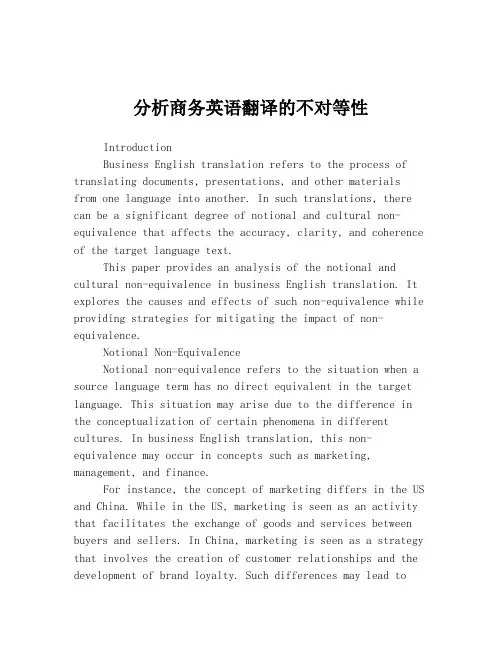
分析商务英语翻译的不对等性IntroductionBusiness English translation refers to the process of translating documents, presentations, and other materials from one language into another. In such translations, there can be a significant degree of notional and cultural non-equivalence that affects the accuracy, clarity, and coherence of the target language text.This paper provides an analysis of the notional and cultural non-equivalence in business English translation. It explores the causes and effects of such non-equivalence while providing strategies for mitigating the impact of non-equivalence.Notional Non-EquivalenceNotional non-equivalence refers to the situation when a source language term has no direct equivalent in the target language. This situation may arise due to the difference in the conceptualization of certain phenomena in different cultures. In business English translation, this non-equivalence may occur in concepts such as marketing, management, and finance.For instance, the concept of marketing differs in the US and China. While in the US, marketing is seen as an activity that facilitates the exchange of goods and services between buyers and sellers. In China, marketing is seen as a strategy that involves the creation of customer relationships and the development of brand loyalty. Such differences may lead tonotional non-equivalence in the translation of marketing materials between the two cultures.Cultural Non-EquivalenceCultural non-equivalence, on the other hand, occurs when the differences in cultural practices create challenges in translating certain artifacts. Cultural practices such as customs, beliefs, values, and behaviors that differ across cultures can create difficulties in business English translation. This non-equivalence may manifest in different ways, such as idiomatic expressions, non-verbal communication, or taboos.For example, in the Chinese culture, the number four is considered unlucky because it sounds similar to the word "death." As such, it is avoided in most business contexts. However, in the western culture, the number four is not associated with any superstition, and its use in business contexts may not have any significant impact. In thetranslation process, this may create non-equivalence in the use of numbers in business documents.Effects of Non-Equivalence in Business EnglishTranslationNon-equivalence in business English translation can have significant effects on the accuracy, coherence, and clarityof the target language text. Firstly, notional non-equivalence can lead to distortions in the meaning of the source language text, leading to misinterpretation or loss of important information. Secondly, cultural non-equivalence may result in the production of inappropriate or erroneous target language texts. These may lead to legal and financialliabilities to the organization involved.Moreover, the impacts of non-equivalence on businesscommunication are significant. It can harm business relations between the two parties involved in the process oftranslation. Non-equivalence can hinder the transfer of knowledge, skills, and expertise, leading to miscommunication and confusion in business contexts.Strategies for Mitigating the Impact of Non-EquivalenceBusiness English translation requires the use of strategies for mitigating the impact of non-equivalence.Below are some of the strategies used:1. Creating a Glossary of TerminologiesA terminology glossary is essential for maintaining consistency in the translation process. It is a list of business terminologies that has been pre-defined and agreed upon by the parties involved. The glossary can serve as a reference point to ensure that words with no direct equivalence are accurately translated.2. Use of Professional TranslatorsHiring a professional translator with expertise in the field of business can mitigate the impact of non-equivalence.A professional translator can accurately translate the source language text while ensuring that the notional and cultural non-equivalence is considered.3. Cultural AwarenessCultural awareness is essential in business English translations. It involves understanding the nuances ofcultural practices, customs, values, and social behavior. The translator needs to have a good understanding of the language, culture, and practices of the target audience.4. ContextualizationContextualization is the process of ensuring that the target language text is appropriate for the culture andcontext of the target audience. The translator should consider the context in which the target language text is used and ensure that it adheres to the cultural practices of the target audience.ConclusionIn business English translation, notional and cultural non-equivalence can have major effects on the accuracy, coherence, and clarity of the target language text. Various strategies can be used to mitigate the impact of non-equivalence, including creating a glossary of terminologies, hiring a professional translator, cultural awareness, and contextualization. Translators must ensure that the target language text is appropriate for the culture and context of the target audience while adhering to the cultural practices of the target audience.。

谈英汉互译的不对等性/h1 ----本站首页免费课件免费试题整册教案教育资讯计划总结英语角幼儿教育文书写作海量教案免费论文网站地图设为首页收藏本站语文科数学科英语科政治科物理科化学科地理科历史科生物科中考备战高考备战高考试题中考试题教学论文作文园地教学论文经济论文理工论文管理论文法律论文行政论文艺术论文医学论文文史论文农科论文英语论文课程改革教育法规教育管理家长频道您现在的位置:3edu教育网免费论文英语论文外语翻译正文3edu教育网,百万资源,完全免费,无需注册,天天更新!谈英汉互译的不对等性摘要: 本文以韩礼德和哈桑的衔接理论为基础,对衔接的主要手段(结构衔接和非结构衔接)作了较详细的理论阐述,并且运用大量的例句作为举例说明,使得学生能够学习、运用这些衔接机制来组织完整连贯的句子。
并在此基础上,对大学英语写作中的衔接教学提出一些感想和建议。
关键词: 翻译;文化传递;文化差异;不对等性; 翻译是把一种语言文字所表达的意义用另一种语言文字表达出来。
但事实上,翻译是一件实践性很强的事情,它绝对不是简单、机械地把一种语言换成另外一种语言的过程。
因为在这个过程当中译者会遇到很多想象不到的实际困难。
语言是文化的一部分,又是文化的载体,它对文化起着重要的作用。
语言翻译不仅是两种语言的互相交换,也是两种文化的传递。
文化在翻译中是不可忽视的因素,正如美国着名翻译家尤金? 奈达所说:“要真正出色的做好翻译工作,掌握两种文化比掌握两种语言甚至更为重要,因为词语只有运用在特定的文化中才具有意义。
例如在翻译工作中,首先遇到的就是词的问题,而要处理好词的问题,首先要明确什么是词。
“不同语言之间词的不对等问题”也是翻译中时时遇到的棘手问题。
翻译中,对等只是一个相对的概念,不对等才是绝对的,完全的对等是不存在的。
因此,对等词的选择也就只能是相对对等词的选择。
不同文化背景的人进行交际的过程是跨文化交际。
不同的民族有着不同的历史背景、风俗习惯、风土人情、文化传统,因此,从事翻译工作的人必须了解掌握本国与异国的民族文化差异,并设法使这些差异在传译过程中消失,同时在译入语中找到准确的词语,使异国文化在译入语中再现。
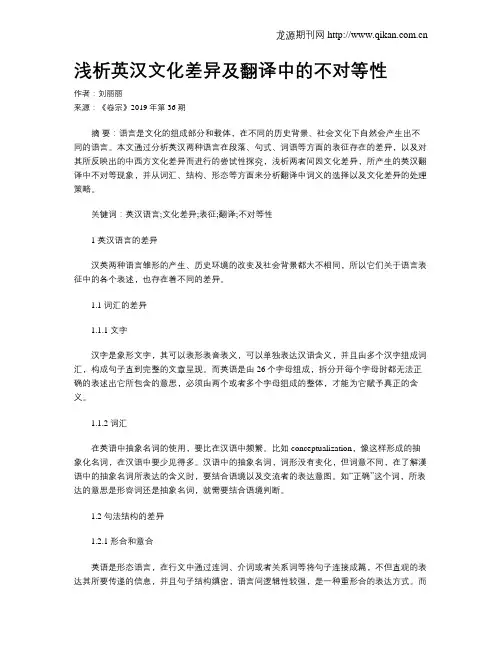
浅析英汉文化差异及翻译中的不对等性作者:刘丽丽来源:《卷宗》2019年第36期摘要:语言是文化的组成部分和载体,在不同的历史背景、社会文化下自然会产生出不同的语言。
本文通过分析英汉两种语言在段落、句式、词语等方面的表征存在的差异,以及对其所反映出的中西方文化差异而进行的尝试性探究,浅析两者间因文化差异,所产生的英汉翻译中不对等现象,并从词汇、结构、形态等方面来分析翻译中词义的选择以及文化差异的处理策略。
关键词:英汉语言;文化差异;表征;翻译;不对等性1 英汉语言的差异汉英两种语言雏形的产生、历史环境的改变及社会背景都大不相同,所以它们关于语言表征中的各个表述,也存在着不同的差异。
1.1 词汇的差异1.1.1 文字汉字是象形文字,其可以表形表音表义,可以单独表达汉语含义,并且由多个汉字组成词汇,构成句子直到完整的文章呈现。
而英语是由26个字母组成,拆分开每个字母时都无法正确的表述出它所包含的意思,必须由两个或者多个字母组成的整体,才能为它赋予真正的含义。
1.1.2 词汇在英语中抽象名词的使用,要比在汉语中频繁。
比如conceptualization,像这样形成的抽象化名词,在汉语中要少见得多。
汉语中的抽象名词,词形没有变化,但词意不同,在了解漢语中的抽象名词所表达的含义时,要结合语境以及交流者的表达意图。
如“正确”这个词,所表达的意思是形容词还是抽象名词,就需要结合语境判断。
1.2 句法结构的差异1.2.1 形合和意合英语是形态语言,在行文中通过连词、介词或者关系词等将句子连接成篇,不但直观的表达其所要传递的信息,并且句子结构缜密,语言间逻辑性较强,是一种重形合的表达方式。
而汉语则是一种含蓄的语言,一种间接的、婉转的表达方式,表面上的表达不太能决定真正意思的准确性,语言和文字是通过承上启下的意境,以及对其他事物的借鉴来体现本身的涵义,是一种重意合的结构。
1.2.2 静态与动态英语是一种静态性的语言结构,动词在英语中由于受到主谓关系的限制,一个主谓关系句中有且仅有一个主要动词,因此它的动作意义常由其他词类来表达,即动词名词化。
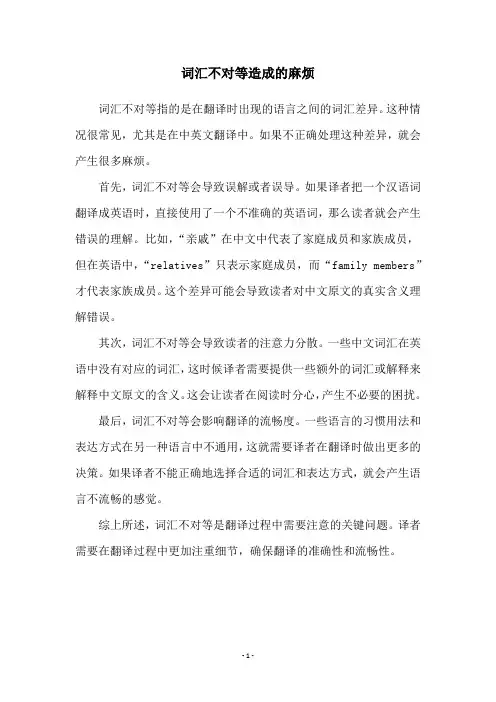
词汇不对等造成的麻烦
词汇不对等指的是在翻译时出现的语言之间的词汇差异。
这种情况很常见,尤其是在中英文翻译中。
如果不正确处理这种差异,就会产生很多麻烦。
首先,词汇不对等会导致误解或者误导。
如果译者把一个汉语词翻译成英语时,直接使用了一个不准确的英语词,那么读者就会产生错误的理解。
比如,“亲戚”在中文中代表了家庭成员和家族成员,但在英语中,“relatives”只表示家庭成员,而“family members”才代表家族成员。
这个差异可能会导致读者对中文原文的真实含义理解错误。
其次,词汇不对等会导致读者的注意力分散。
一些中文词汇在英语中没有对应的词汇,这时候译者需要提供一些额外的词汇或解释来解释中文原文的含义。
这会让读者在阅读时分心,产生不必要的困扰。
最后,词汇不对等会影响翻译的流畅度。
一些语言的习惯用法和表达方式在另一种语言中不通用,这就需要译者在翻译时做出更多的决策。
如果译者不能正确地选择合适的词汇和表达方式,就会产生语言不流畅的感觉。
综上所述,词汇不对等是翻译过程中需要注意的关键问题。
译者需要在翻译过程中更加注重细节,确保翻译的准确性和流畅性。
- 1 -。
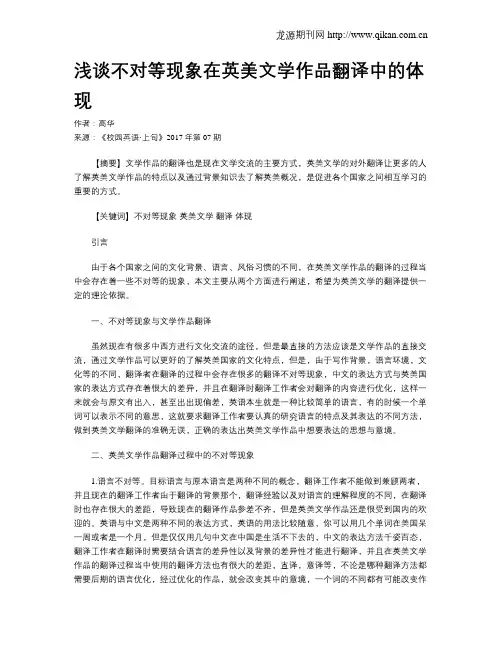
浅谈不对等现象在英美文学作品翻译中的体现作者:高华来源:《校园英语·上旬》2017年第07期【摘要】文学作品的翻译也是现在文学交流的主要方式,英美文学的对外翻译让更多的人了解英美文学作品的特点以及通过背景知识去了解英美概况,是促进各个国家之间相互学习的重要的方式。
【关键词】不对等现象英美文学翻译体现引言由于各个国家之间的文化背景、语言、风俗习惯的不同,在英美文学作品的翻译的过程当中会存在着一些不对等的现象,本文主要从两个方面进行阐述,希望为英美文学的翻译提供一定的理论依据。
一、不对等现象与文学作品翻译虽然现在有很多中西方进行文化交流的途径,但是最直接的方法应该是文学作品的直接交流,通过文学作品可以更好的了解英美国家的文化特点,但是,由于写作背景,语言环境,文化等的不同,翻译者在翻译的过程中会存在很多的翻译不对等现象,中文的表达方式与英美国家的表达方式存在着很大的差异,并且在翻译时翻译工作者会对翻译的内容进行优化,这样一来就会与原文有出入,甚至出出现偏差,英语本生就是一种比较简单的语言,有的时候一个单词可以表示不同的意思,这就要求翻译工作者要认真的研究语言的特点及其表达的不同方法,做到英美文学翻译的准确无误,正确的表达出英美文学作品中想要表达的思想与意境。
二、英美文学作品翻译过程中的不对等现象1.语言不对等。
目标语言与原本语言是两种不同的概念,翻译工作者不能做到兼顾两者,并且现在的翻译工作者由于翻译的背景那个,翻译经验以及对语言的理解程度的不同,在翻译时也存在很大的差距,导致现在的翻译作品参差不齐,但是英美文学作品还是很受到国内的欢迎的。
英语与中文是两种不同的表达方式,英语的用法比较随意,你可以用几个单词在美国呆一周或者是一个月,但是仅仅用几句中文在中国是生活不下去的,中文的表达方法千姿百态,翻译工作者在翻译时需要结合语言的差异性以及背景的差异性才能进行翻译,并且在英美文学作品的翻译过程当中使用的翻译方法也有很大的差距,直译,意译等,不论是哪种翻译方法都需要后期的语言优化,经过优化的作品,就会改变其中的意境,一个词的不同都有可能改变作者要表达的意思,所以,这对翻译工作者就有更大的要求,翻译工作者翻译能力的高低决定了这篇作品质量的高与低,语言不对等是现在翻译工作中最重要的也是最常见的不对等现象,要想对英美文学作品进行准确的翻译,翻译工作者必须克服语言的障碍,深入了解英文的表达手法与表达方式,为读者提供更加准确、质量高的英美文学作品,了解当时的写作背景,结合写作背景进行翻译会更加的有效。

商业故事BUSINESS STORY120教育教学・Education摘要:在翻译的实践之中,文化背景,思维认知的差异,这就使得汉法翻译中绝对对等成为一件很困难甚至是难上加难的事情。
关键词:不对等性;限度;翻译;翻译策略引言:不同的语言文化特征是每个国家都具有的,但是语言和文化有是密不可分的。
但是由于各个民族,各个国家所处的自然环境,地理环境,文化环境及历史与人文等因素的不同,他们对外界所产生的印象及观念也会有很大的差异,所以不同的文化背景就会形成不同的文化认知。
所以,具有不同文化意思的句子,汉法翻译的不对等性就因此就产生了。
汉语和法语有着不同的文化背景,而这两种语言所经历的文化又不尽相同,所以在不同的地方,不同的文化表达就形成了,而汉法翻译的不对等性就是这些相异之处的极端反映。
在我们看来,语言很美,但是存在决定这我们的思维,每种语言都有自己特定意义的文化历史、民族历史、民族文化、民族心理背景,所以就像中国与法国这两个说着不同语言的国家之间的这个鸿沟也是不可能被跨越。
世界的丰富多彩也有语言的不同而决定,但是,跨文化的交流却因此而被阻塞了,也带来了很多难处。
但是,我们应该清楚地看到,两个国家之间能否更好的交流也依赖于我们对语言的精细研究,只有这样,只有做到了这些,我们不同国家之间,不同文化之间才能更好滴去交流。
根据出现的汉法翻译中不对等现象的出现,进行了各方面的调查研究,其结果、主要因素如下:1语义和词义角度不对等由于生活环境的不同、经历的不同、文化的不同,正是不同的文化影响,同一事物中,人们就产生了不同的观点。
就比如,西方人认为,我们所尊崇的神圣动物龙并不是一种友好的代表,用它去代表了邪恶。
在中世纪,龙是罪恶的象征,另外,龙还有“泼妇’的意思,由此可知,我们口中所说的龙跟西方人严重的龙并不是等同的,甚至可以说不是同一个动物,所以,那些译者在翻译时就要格外注重了。
东亚韩国、中国台湾、中国香港和新加坡四个经济较为发达的国家和地区,被西方人称为“亚洲四小龙”,在翻译时,直白翻译并不是十分恰当。
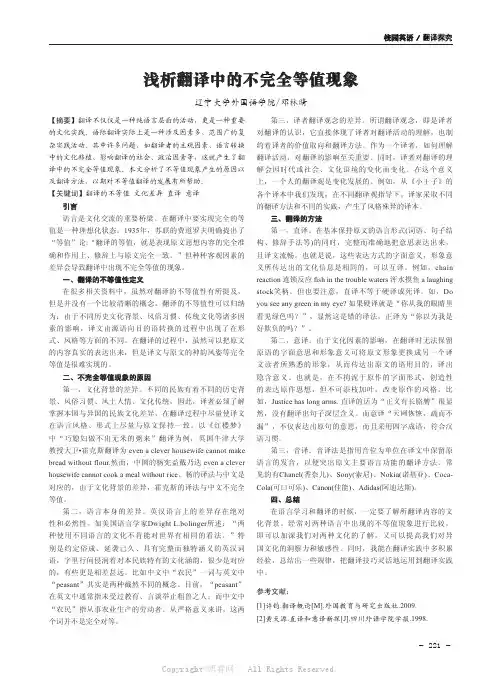
- 221 -校园英语 / 翻译探究浅析翻译中的不完全等值现象辽宁大学外国语学院/邓林晴【摘要】翻译不仅仅是一种纯语言层面的活动,更是一种重要的文化实践。
语际翻译实际上是一种涉及因素多、范围广的复杂实践活动。
其中许多问题,如翻译者的主观因素、语言转换中的文化移植、影响翻译的社会、政治因素等,这就产生了翻译中的不完全等值现象。
本文分析了不等值现象产生的原因以及翻译方法,以期对不等值翻译的发展有所帮助。
【关键词】翻译的不等值 文化差异 直译 意译引言语言是文化交流的重要桥梁。
在翻译中要实现完全的等值是一种理想化状态。
1935年,苏联的费道罗夫明确提出了“等值”论:“翻译的等值,就是表现原文思想内容的完全准确和作用上、修辞上与原文完全一致。
”但种种客观因素的差异会导致翻译中出现不完全等值的现象。
一、翻译的不等值性定义在很多相关资料中,虽然对翻译的不等值性有所提及,但是并没有一个比较清晰的概念。
翻译的不等值性可以归纳为:由于不同历史文化背景、风俗习惯、传统文化等诸多因素的影响,译文由源语向目的语转换的过程中出现了在形式、风格等方面的不同。
在翻译的过程中,虽然可以把原文的内容真实的表达出来,但是译文与原文的神韵风姿等完全等值是很难实现的。
二、不完全等值现象的原因第一,文化背景的差异。
不同的民族有着不同的历史背景、风俗习惯、风土人情、文化传统,因此,译者必须了解掌握本国与异国的民族文化差异,在翻译过程中尽量使译文在语言风格、形式上尽量与原文保持一致。
以《红楼梦》中“巧媳妇做不出无米的粥来”翻译为例,英国牛津大学教授大卫•霍克斯翻译为 even a clever housewife cannot make bread without flour.然而,中国的杨宪益戴乃迭 even a clever housewife cannot cook a meal without rice 。
杨的译法与中文是对应的,由于文化背景的差异,霍克斯的译法与中文不完全等值。
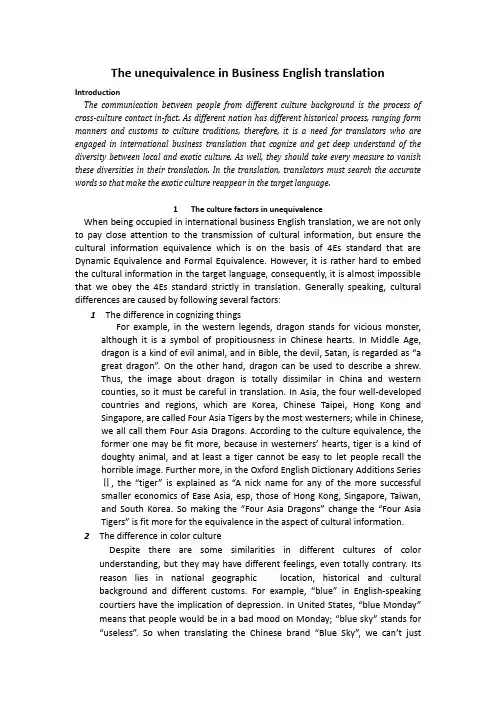
The unequivalence in Business English translationIntroductionThe communication between people from different culture background is the process of cross-culture contact in-fact. As different nation has different historical process, ranging form manners and customs to culture traditions, therefore, it is a need for translators who are engaged in international business translation that cognize and get deep understand of the diversity between local and exotic culture. As well, they should take every measure to vanish these diversities in their translation. In the translation, translators must search the accurate words so that make the exotic culture reappear in the target language.1 The culture factors in unequivalenceWhen being occupied in international business English translation, we are not only to pay close attention to the transmission of cultural information, but ensure the cultural information equivalence which is on the basis of 4Es standard that are Dynamic Equivalence and Formal Equivalence. However, it is rather hard to embed the cultural information in the target language, consequently, it is almost impossible that we obey the 4Es standard strictly in translation. Generally speaking, cultural differences are caused by following several factors:1The difference in cognizing thingsFor example, in the western legends, dragon stands for vicious monster, although it is a symbol of propitiousness in Chinese hearts. In Middle Age, dragon is a kind of evil animal, and in Bible, the devil, Satan, is regarded as “a great dragon”. On the other hand, dragon can be used to describe a shrew.Thus, the image about dragon is totally dissimilar in China and western counties, so it must be careful in translation. In Asia, the four well-developed countries and regions, which are Korea, Chinese Taipei, Hong Kong and Singapore, are called Four Asia Tigers by the most westerners; while in Chinese, we all call them Four Asia Dragons. According to the culture equivalence, the former one may be fit more, because in westerners’ hearts, tiger is a kind of doughty animal, and at least a tiger cannot be easy to let people recall the horrible image. Further more, in the Oxford English Dictionary Additions Series Ⅱ, the “tiger”is explained as “A nick name for any of the more successful smaller economics of Ease Asia, esp, those of Hong Kong, Singapore, Taiwan, and South Korea. So making the “Four Asia Dragons”change the “Four Asia Tigers” is fit more for the equivalence in the aspect of cultural information.2 The difference in color cultureDespite there are some similarities in different cultures of color understanding, but they may have different feelings, even totally contrary. Its reason lies in national geographic location, historical and cultural background and different customs. For example, “blue” in English-speaking courtiers have the implication of depression. In United States, “blue Monday” means that people would be ina bad mood on Monday; “blue sky” stands for “useless”. So when translatingthe Chinese brand “Blue Sky”, we can’t just translate it literally, otherwise, thewesterners regard it as “useless thing”. In addition, the Egyptians and Belgians look on blue as an unlucky color. In Chinese, blue generally won’t cause “melancholy”or “unlucky”impression. Nonetheless, the world famous brand “Blue Bird”isn’t “sad”car, or how could it be a great brand known around world. Blue bird is a kind of blue songbird come from North America, and its meaning in cultural orientation is happy. So the actual meaning is driving for happy. But in China, most people couldn’t feel the Chinese, “fu”, only do enjoy the feels of the symbol about wealth and reflect.In English-speaking nations, people believe that red stands for brutal and unlucky, and red means to bleed. However in China, red is a happy and lucky color. In the Chinese traditional marriage ceremony, the new couples are used to put on in red. In business, the businessmen hope “open red”; when being profitable, they will get the “red profits”; and the employees will get the “red bags” if they do well in work.3The difference in numerical cultureAll is known that, in the west, “13”is considered as an unlucky number, whose reason is related to the story in the Bible that Jesus was sold by his thirteenth follower-----Judas. So in the western countries, people usually avoid using this number. In China’s traditional culture, the digital “13”has no such cultural meaning, but with the influence of western culture, the recent implication is also acceptable to people.In China’s pronunciation, the “nine”has the same sound as “long”, so naturally “nine”has the ame meaning as “long”in China. For example, the Chinese emperors all worship the number “nine”, hoping his country has long peace. As the same reason, there is a medicine brand named “999”, but in English culture, the “nine” has not the same implication. In addition, we can’t put “666”or such like trademark goods export into British, because “666”stands for the symbol of devil.“Seven”has a positive meaning in Europe and United States. Therefore, the drink trademark “7-Up”is translated as “QI-Xi”in Chinese rather than just “Seven-Up”. In the minds of English-speaking countries, “7” is equivalent to the Chinese people’s minds of “Eight”. “Seven” is a lucky number as to westerners, trademark such as Mild Seven, Seven-Eleven. But in China, it is just a general figure.2 As to the unequivalenceCultural information transfer is possible mainly through translating to understand other cultures and cultural information of equivalence is also possible. We could rely on MrNida’s“Functional Equivalence”principle. “Equivalence”here cannot be understood mathematicalsense for equivalence, and they are only similar with each other. He thought of the translation should aim at the equivalence in the aspects of information content, manner of speaking, style, language, culture, and social factors and so on. In order to achieve these equivalences, we must ne adjusted in translation.If there are misunderstandings in the form-close translated texts, we must make some change about the texts in characters; we can retain some transliterations aswell, but it is a need to add the footnotes to explain the potential misunderstandings. If the translation is close to the original in form, it may lead to the original associative meanings of misunderstanding, or the heavy losses on the correct understanding of the original style, then that it ask for the necessary adjustments to reflect the original association value is important. For example, Chinese wines “Dukang” translated into English is generally based on sound translation, but when seeing the English trademark Dukang, the English-speaking readers only make it relate to wine, but not thinking of wine master in Chinese history. Therefore, “Dukang” as a trademark, cultural information is not entirely so. However, we might use the Greet god of wine in the name of Bacchus, replacing “Dukang” as the English language marks, so that cultural information is no doubt much better, as Bacchus would let westerners produce more relevant associations.A translation of original must be produced with the accompanying code, which is often called to make a series of adjustments in phonemes, vocabulary, syntax and discourse in various dimensions. For example, Nike, as a trademark, can make English-speaking countries think of victory, good fortune, because the world in Greek mythology, Nike is the goddess of victory. Legendary Nike has long wings, holding on olive branch, bringing victory to the people and gods gift, and she is lucky, the god of justice and beauty. Nile as a sporting goods trademark, we can put it transliterated as “Naike”, implying that Nike is durable, sturdy and beat the opposition in the race. “Naike” can be a good translation, but what Chinese think of is totally different form whatEnglish-speaking people do, and Chinese may not think of the goddess. Cultural information is lost in translation.ConclusionEach nation has its unique culture. East and West have a different philosophy, cultural traditions, so there is bound to cultural differences. In addition, the reason for the difference lies in the different East and West national geography, history, folklore and customs. It is these cultural differences that can make the translatability to be restricted. English translation of international business must pay special attention to these differences and we should also find the relevant point between a foreign culture and their own culture. It is most desirable if the relevant point is a blend of two cultures. However, often due to cultural differences, sometimes it id difficult to find appropriate points, then translator must be on their abilities so that the two cultures can be as close as possible. In accordance with the 4Es standards and Mr. Nida’s principles, we could make appropriate adjustments to bring something exotic to reproduce in the target language.参考文献1.关世杰《跨文化交流学》北京大学出版社;19952.刘醒吾《经贸英语口语》外语教学与研究出版社;19973.李平《国际经贸英语教程》中国国际广播出版社;19994.王学文《新编经贸口译教程》中国对外经济贸易出版社;20015.张培基,喻云根等《英汉翻译教程》上海外语教育出版社, 19886.金惠康《跨文化交际翻译续编》中国对外翻译出版公司,20047.毛荣贵,廖晟《译谐译趣》中国对外翻译出版公司, 20058.李巍《广告设计概论》西南财经大学出版社, 20029.董立津Jason Pugh 《广告专业英语》中南大学出版200110.The Advanced Learner’s Dictionary of Current English Oxford University Press , 1963.11.Jeffrey Sachs:InternationalEconomics:Unlocking the Mysterise of Globalization12.[J].Foreign Policy,Spring,1998.13.Anthony Giddens:The Consequence of Modernity [M].Cambridge Press,1996.14.Samir Amin:The Challenge of Globalization [J].Cambridge Press,1996.15.Jeffrey.A,Frankel:Globalization of the Economy [N].NBER WorkingPaper,No.7858,August,2000.。
龙源期刊网 http://www.qikan.com.cn 浅析商务英语翻译中的不对等性 作者:杨雪琴 来源:《科教导刊·电子版》2014年第16期
摘 要 进行国际商务英语翻译时必须特别注意文化差异,必须在外国文化和本国文化中找到一个切合点。按照4Es标准和奈达先生的翻译原则,做出适当的调整,使带异国情调的东西在译入语中得以再现。
关键词 商务英语 翻译 不对等性 中图分类号:H315.9 文献标识码:A 语言是文化的一部分,又是文化的载体,它对文化起着重要的作用。语际翻译不仅是两种语言的互相交换,也是两种文化的传递。文化在翻译中是不可忽视的因素,正如美国著名翻译家尤金·奈达所说:“要真正出色的做好翻译工作,掌握两种文化比掌握两种语言甚至更为重要,因为词语只有运用在特定的文化中才具有意义。”
从事国际商务英语翻译要注意文化信息的传递,尽量按照国际商务英语翻译的4Es标准做到文化信息对等。然而,在实际工作中,文化信息有时很难传递到译入语中,结果对等的标准就不能完全做到。
文化差异受地理位置、社会制度、历史等的不同因素的影响。文化差异会引起几种不对应的情况:
(1)原语中的指称对象在译入语文化中根本不存在、罕见或被忽视。例如,汉语里有许多用数字开头的词语,如“三心二意”译为neither off nor on.“三个臭皮匠,赛过诸葛亮”译为Two heads are better than one。这些词语通常不能按字面意思翻译。
(2)原语文化在概念上有明确的实体,而译入语文化不加以区分或恰恰相反。例如,英语中的armchair指任何有扶手的、硬的或软的椅子,但在汉语中我们却分别有“扶手椅”和“单人沙发”。
(3)和译入语中同一个指称对象可能由字面意义不同的词语加以指称。例如,英语的black tea,翻译成汉语是“红茶”,而不是“黑茶”。这是因为中国人注意的是茶水的颜色,而英国人重点放在茶叶的颜色上。
从文化差异看英汉翻译的不对等性作者:黄媛媛来源:《考试周刊》2013年第01期摘要:两种语言翻译的不对等性是译者最困惑的问题。
在翻译实践中,文化背景、思维认知及固有的本族语使用差异,使译者在翻译过程中出现更多困难。
英语和汉语是建立在不同文化基础上的两种语言,文化差异将会给英汉翻译带来一定的影响,只有了解英、汉两种语言风格的异同、文化背景知识和不同的民族心理状态,缩短这种文化差异,才能成功地进行翻译交际。
关键词:不对等性文化差异影响语言是一个民族文化的结晶。
每个民族所处的自然条件、社会环境、历史状况不同,其文化也自然而然地呈现出各式各样的形态,进一步引发思维认知及语言方式等诸多不同,从而造成翻译中的不对等现象。
英语和汉语是建立在不同文化基础上的两种语言。
在翻译实践中,译者往往需要结合两种不同文化,进行灵活的不对等性翻译,体现译语要传递的效果。
总的来说,可以从地理环境、风俗习惯、宗教信仰、历史典故及思维方式等五个主要方面入手把握其中的文化差异,寻找最合适的翻译方式。
一、从生存环境的差异入手西方的语言多与水有关,代表海洋文化,因为西方的航海业曾一度领先于世界,水产捕捞也是其经济发展不可或缺的因素;而中国在亚洲大陆上生活繁衍,人们以农耕为主要经济方式,汉语语言因而多数与山川、江湖、四季、农耕等方面有关。
这种生存环境的差异常常反映在相应的英语词汇和汉语词汇上。
比如,西方人在形容“花钱大手大脚,毫无节制”时通常会说“to spend money like water”——“花钱如流水”;而生活在大陆上的中国人则会说“挥金如土”。
因为水在西方是“安全祥和”的象征,英语中“to be left high and dry”一词应译为“陷入困境”,而中文中并无相关寓意,因此不能直译为“被留在水流不到的地方”。
由于中西方的地理特征,无论是历史传统还是现实生活中都相差太大,汉语里很多描述在英语中也无法对等表述出来。
如“山重水复疑无路,柳暗花明又一村”,我们很难在英文中找到相似的语境,即使将山、水、路、柳、花、村等词一一对应,也无法有对等的联想。
浅析翻译中源语言与目的语不对等情况的翻译方法——以英语翻译为例百家论点浅析翻译中源语言与目的语不对等情况的翻译方法——以英语翻译为例李璐仲雅荧(扬州大学外国语学院翻译系,江苏扬州225000)摘要:翻译对等在狭义上指内容方面,包括语气、用词、风格等方面要忠实于原文;而广义上还包括思想、感情、立场等方面的忠于原文。
如此一来,翻译过程就包含了转化“字面意义、结构意义、社会文化意义”的三重意义。
我们所要研究的就是如何将这三种意义结合起来,尽可能地满足这三方面的要求。
关键词:翻译;不对等;功能对等;目的语;方法1引言所谓翻译,简单来说就是将一种语言通过各种方法进行文字的再加工,经过各种方式的重新排列组合转换成另一种或多种语言的过程。
美国著名的翻译家、翻译理论家尤金·A·奈达以“功能对等”翻译理论闻名于世,他提出包括:词汇对等、句法对等、篇章对等、文体对等。
2词汇不对等受到一种语言自身实用搭配等习惯和另一种语言所处的民族文化和历史,地域等多种因素的影响和限制,在很多情况下就难以找到与之相对应的既能完整准确表达意思,又符合目的语用语习惯的词汇。
基于此,不妨将词汇不对等情况进一步细分。
2.1文化概念的空缺引起的词汇空缺不仅仅是在英语和汉语两种文化中才会出现这种现象,任何两种不同的文化多多少少都会有。
比如说Salad这种凉拌菜起源于法国,英国人最先没有这道菜,语言中也不存在这个同,因此只好从法语中原封不动地“移植”过来,汉语也是如此。
如:golf(高尔夫)、disco(迪斯科)等。
2.2背景不同造成文化内涵存在差异就英语和汉语词汇的本身所具有的多样性来讲,一个英文单词或是一个中文汉字就可以代表多重意义。
一个很经典的例子就是关于吃饭的问题。
在我国,吃饭问题长期以来都是人们特别关心的问题。
3句法不对等句法是研究句子的个个组成部分和它们的排列顺序。
句法研究的对象是句子,而句子又是语言运用的基本单位。
1
浅谈翻译中的不对等性
摘 要:随着翻译研究的“文化转向”,翻译研究的传统思路受到了冲击,取
而代之的是新的研究范式。在回顾翻译研究传统思路的基础之上,本文对翻译中
的不对等性的问题作出了简要的阐述。
关键词:翻译;不对等性;文化差异
翻译是指在准确通顺的基础上,把一种语言信息转变成另一种语言信息的行为。
翻译是将一种相对陌生的表达方式,转换成相对熟悉的表达方式的过程。其内容
有语言、文字、图形、符号的翻译。事实上,翻译是一件实践性很强的事情,它
绝对不是简单、机械地把一种语言换成另外一种语言的过程。因为在这个过程当
中译者会遇到很多想象不到的实际困难。语言是文化的一部分,又是文化的载体,
它对文化起着重要的作用。因此,从事翻译工作的人必须了解掌握本国与异国的
民族文化差异,并设法使这些差异在传译过程中消失,同时在译入语中找到准确
的词语,使异国文化在译入语中再现。本文就翻译中词的不对等现象进行探讨并
提出几点解决方法。
一、对事物认识的文化差异
在西方神话传说中,dragon不是中国人心中的吉祥动物,而是表示邪恶的怪物。
在中世纪,dragon 是罪恶的象征,圣经故事中恶魔撒旦(Satan) 就被认为是the
great dragon。另外,dragon 还有“泼妇’的意思,由此可知,dragon 在英语
国家人中所引起的联想与中国人的“龙”完全不同,所以,翻译时就要特别小心。
东亚韩国、中国台湾、中国香港和新加坡四个经济较为发达的国家和地区,被西
方人称为“亚洲四小龙”,将其翻译成英语Four Asian Dragons 恐怕不太妥当。
有人建议翻译成Four Asian Tigers,这不失为一种较好的文化信息的对等,因
为tiger 在西方人心中是一种强悍的动物,至少不会让人联想到某种可怕的动
物。所以说,将“亚洲四小龙’翻译成Four Asian Tigers 在文化信息方面基
本达到了对等。再如,我国著名的“白象”牌电池,翻译成英语White Elephant,
语义信息对等虽然不错,但从文化信息对等来看却是糟糕的翻译,因为white
elephant 在西方国家中意思是“没有用反而累赘的东西”。由此可知,英语国
家的人恐怕不会买牌子为White Elephant的电池,因为消费者不愿买“没有用
反而累赘的东西”。那么。“白象”牌电池应该怎样翻译呢? 我们可以考虑用一
种西方人心中象征着强大、有力量的动物lion来代替,将“白象”译成Brown
Lion。如果买来的电池威力无比,顾客何乐而不为呢?
二、颜色的文化差异
不同文化的人对颜色的认识尽管有相似之处,但他们对各种颜色的感觉有可能不
同,甚至截然相反,其原因在于国家所处的地理位置、历史文化背景和风俗习不。
例如,蓝色在英语国家有忧郁的含义,美国有“蓝色星期一”(blue Monday),
指心情不好的星期一。blue sky 在英语中意思是“没有价值”,所以,把“蓝
天”牌台灯翻译成Blue sky Lamp,意思便是“没有用的台灯”,这样的台灯怎
能销得出去呢? 另外,埃及人和比利时人视蓝色为倒霉的颜色。蓝色在中国人心
中一般不会引起“忧郁”或“倒霉”的联想。尽管如此,世界知名品牌“蓝鸟”
汽车并不是“伤心的鸟”的汽车,否则怎么会用Blue Bird 作为汽车商标呢?
blue bird 是产于北美的蓝色鸣鸟,其文化含义是“幸福”,所以,英语国家人
驾驶Blue Bird 牌的汽车,心中的文化取向是“幸福”。但是,驾驶Blue Bird
牌汽车的中国人恐怕不知道身在“福”中,而只感到驾驶世界名牌汽车是一种身
2
价的体现和财富的象征。再如英语国家视“红色”为残暴、不吉利,红色意味着
流血。在中国红色预示着喜庆,中国人结婚习惯穿红色衣服。经商时,商人希望
“开门红”。经营赚钱了,大家都来分“红利”。某员工工作出色,老板发给他
“红包”。美国人一般不喜欢紫色;法国入不喜欢墨绿色却偏爱蓝色。
三、与特定文化有关的词的不对等
由于英汉两种语言的文化背景不同, 不同民族的历史地理,文化传统等因素存在
差异, 在译出语中存在的代表特定文化的词语在译入语中不存在. 如某些西方
宗教信仰, 社会风俗, 甚至某一种食物是一个民族, 地区特有的, 不存在于其
他民族和地区. 例如:由于文化差异,一个词的概念在英语中可能与汉语中完全
不同。将“speaker” 译为“chairman”则不能反映出“speaker”的真实身份
和权力。又如“ 拜年 (pay New Year call)”是中国特有的民俗文化, 特指在
中国农历新年时亲戚朋友之间互相拜访, 交流感情.中国人注重社会以及人际之
间的交流, 过年时拜年也是几千年来流传的习俗, 而西方人相对独立, 也没有
过年时拜年的习惯, 因此没有特定对应的词存在. Pizza 是西方人非常喜欢的
一种食品, 有点像中国的馅饼. 在中国的传统观念里是缺少这一概念的, 自然
是没有对应的词来翻译, 而翻译成馅饼又明显是不合适的。我们都知道,食物中
含盐是很重要的,但过多又有害,所以西方人在餐后会补充一些,对于这个含义
我们很容易理解,但是要表用相应的词来表达这个含义,在我们汉语是不可能的。
这也是一种不对等。
文化信息的传递是完全可能的,主要是通过翻译了解他国文化。文化信息的对等
也是可能的,我们可以遵循奈达先生的“功能对等”(Functional Equivalence)
原则,这里的“对等”不能理解为数学意义上的等同,只能是近似的等同,即以
功能对等接近程度为依据的近似。他认为翻译的目的应该是原文和译文在信息内
容、说话方式、文体、文风、语言、文化、社会因素诸方面达到对等。为了达到
这些对等,必须在翻译中进行调整。
参考文献:
[1]谭载喜,翻译学必须重视中西译论比较研究[J].中国翻译,1998(2):12-16.
[2] 龚嵘,《英语流行话题阅读》[M].华东理工大学出版社2006,5
[3]刘季春,《实用翻译教程》[M]. 广州:中山大学出版社2007,8
[4]范仲英,《实用翻译教程》[M].北京:外语教学与研究出版社,1994,6